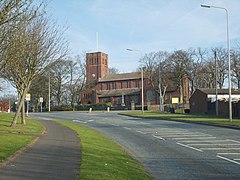Rowley Regis
| Rowley Regis | |
|---|---|
 St. Giles Church, parish church of Rowley Regis |
|
| Rowley Regis shown within the West Midlands | |
| Population | 50,257 (2011) |
| OS grid reference | SO9687 |
| Metropolitan borough | |
| Metropolitan county | |
| Region | |
| Country | England |
| Sovereign state | United Kingdom |
| Post town | CRADLEY HEATH/ ROWLEY REGIS |
| Postcode district | B64, B65 |
| Dialling code | 0121, 01384 |
| Police | West Midlands |
| Fire | West Midlands |
| Ambulance | West Midlands |
| EU Parliament | West Midlands |
| UK Parliament | |
Rowley Regis is a historic parish and former municipal borough, in the Black Country region of the West Midlands, England. Considered one of the six 'towns' that comprise the modern-day Sandwell Metropolitan Borough, it encompasses the wards of Blackheath, Cradley Heath and Old Hill, and Rowley Village. At the 2011 census, the combined population of Rowley Regis was 50,257.
The history of Rowley Regis began in the 12th century, when a small village grew around the parish church of St. Giles, approximately two miles south-east of the town of Dudley. Rowley was part of the Royal hunting grounds - Regis was added to the name of Rowley in around 1140 to signify it was that part of Rowley belonging to the King. It began to develop substantially between the two world wars, when thousands of privately owned and local authority houses were built in the surrounding area. During that time Rowley Regis became a borough, and incorporated the communities of Blackheath, Old Hill, and Cradley Heath. These places were all within the ancient parish of Rowley Regis, which (despite being in the county of Staffordshire) was in the diocese of Worcester. The parish contained the manors of Rowley Regis and Rowley Somery, the latter being part of the barony of Dudley, but the extents of these manors and the relationship between them are not clear.
The present St. Giles Church on Church Road is not the original church in Rowley Regis. It was designed by Holland W. Hobbiss and A. S. Dixon, and was built in 1923. The previous church, built in 1904, was burned down in 1913, some believing the fire to have been started by Suffragettes or local striking steelworkers; this however is supposition and it was more than probable it was a simple accident, the church at this time using parrafin as a means of lighting and the latter perhaps causing the fire. . The second church, built in 1840, was found to be unsafe and condemned in 1900.
...
Wikipedia

